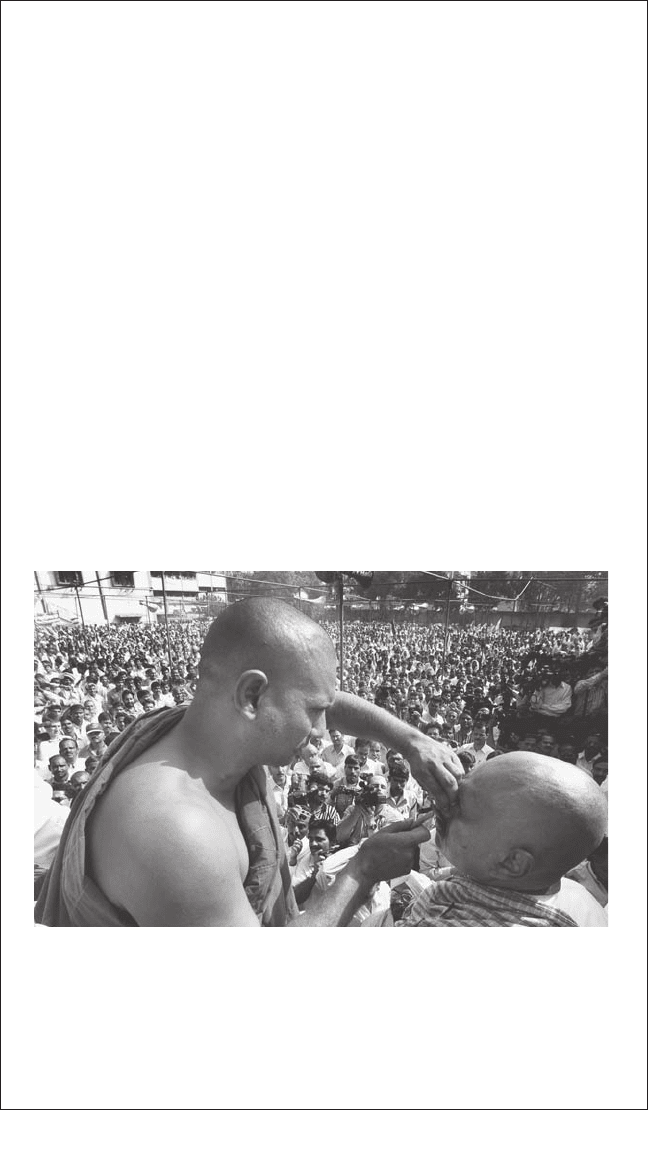Walsh J.E. A Brief History of India
Подождите немного. Документ загружается.


A BRIEF HISTORY OF INDIA
222
no objections to the fi nal settlement. The viceroy, Lord Mountbatten,
hearing that Gandhi opposed partition, had called for a meeting. “It
happened to be a day of silence [for Gandhi],” Mountbatten later
recalled, “for which I was grateful. In retrospect I think he chose to
make that a day of silence to save him the embarrassment of accepting
the Partition. For he had no other solution” (Brecher 1961, 141). Less
than a year later Gandhi was dead, the most famous victim of partition
violence and upheaval. It would now be his heirs and successors in the
new government of India who would take on the responsibility of shap-
ing the newly independent Indian state.
001-334_BH India.indd 222 11/16/10 12:42 PM

223
8
Constructing the
Nation (1950–1996)
WE, THE PEOPLE OF INDIA, having solemnly resolved to constitute
India into a SOVEREIGN SOCIALIST SECULAR DEMOCRATIC REPUBLIC
and to secure to all its citizens:
JUSTICE, social, economic and political;
LIBERTY of thought, expression, belief, faith and worship; EQUALITY of status
and of opportunity; and to promote among them all FRATERNITY assuring
the dignity of the individual and the unity and integrity of the Nation;
IN OUR CONSTITUENT ASSEMBLY this twenty-sixth day of November,
1949, do HEREBY ADOPT, ENACT AND GIVE TO OURSELVES
THIS CONSTITUTION.
Preamble to the Indian Constitution, 1949, and as amended in 1976
(Hay 1988, 335–336)
A
fter independence and partition came the work of creating the
new Indian nation. For more than 50 years the Congress Party had
fought India’s British rulers; now Congressites had to re-create them-
selves and their party and build a modern state within the context of a
free and independent country. Almost 30 years of provincial elections
had already accustomed Indian leaders to competing for power through
the ballot box. Not surprisingly then, the Indian Constitution, accepted
in 1949 to take effect in 1950, defi ned India as a democratic republic.
India’s fi rst leaders also defi ned the new republic as both socialist and
secular, although this was not written into the constitution until 1976.
Years of British imperialism had convinced Jawaharlal Nehru and many
like him that only a socialist state, with a commitment to social and
economic justice and an emphasis on centralized state planning, could
ameliorate the deep poverty of India’s people. The need for a secular
001-334_BH India.indd 223 11/16/10 12:42 PM

A BRIEF HISTORY OF INDIA
224
state, a second absolute commitment of the early Indian republic, had
been underscored by partition’s violent communal confl icts. For almost
20 years, from 1947 to his death in 1964, Nehru worked with his
Congress colleagues to build India within these three defi ning rubrics:
democratic, socialist, and secular.
The decades from Nehru’s death to the end of the 20th century, how-
ever, would see substantial challenges raised to all three of these early
commitments. In the decades after 1947, events demonstrated that
electoral politics, far from uniting Indians, also had the potential to tear
them apart. With Indira Gandhi’s (1917–84) defeat at the polls in 1977
and the subsequent defeat of her opposition in 1980, it also became
clear that the voters of the largest democratic system in the world
would not always necessarily return elected offi cials to power. Similarly,
socialist state planning was challenged as early as the late 1960s and
1970s as it became clear that neither central economic planning nor
the absence of home charges would immediately transform India’s
economy. Finally, the decades after independence, and particularly the
last 20 years of the 20th century, demonstrated frequently and dramati-
cally the diffi culties inherent in fi tting India’s castes, religions, regional
cultures, and linguistic divisions into the conceptual framework of a
secular state. The 1980s and 1990s saw the rise of an aggressive Hindu
nationalist movement that by 1996 looked able, not only to take power,
but also to challenge the basic premise of Indian secularism.
From Dominion to Republic
The caretaker dominion government of 1947 was headed jointly by
Nehru as prime minister and Sardar Patel as deputy prime minister.
Nehru’s public pronouncements refl ected his and the Congress left wing’s
secular and socialist convictions; however, Patel, who came from the
more conservative and communalist wing of Congress, said less in public
but controlled the Congress organization. By 1948 Patel and his faction
had forced all socialists out of Congress, causing them to form the Praja
Socialist Party in 1952. Patel’s sudden death in 1950, however, left Nehru
back at the center of government functions and essentially unopposed.
The work of writing the new constitution was directed by B. R.
Ambedkar, now minister of law in the cabinet, and approved by
the Constituent Assembly in 1949. The constitution became law on
January 26, 1950. Its preamble guaranteed all Indian citizens justice,
liberty, equality, and fraternity. A section on “fundamental rights”
granted citizens a wide range of basic civil liberties (such as freedom of
001-334_BH India.indd 224 11/16/10 12:42 PM

225
CONSTRUCTING THE NATION
speech, assembly, travel) and abolished the practice of Untouchability
“in any form” (Hay 1988, 336–337). Under British Indian law, separate
legal codes had existed for the personal law of both the Hindu and the
Muslim communities. At Patel’s insistence the constitution left these
separate legal codes intact.
The constitution established a parliamentary form of government,
modifi ed by the addition of an independent Supreme Court modeled
on that of the United States. Asked by Gandhians in the Constituent
Assembly why the government was not based on indigenous village sys-
tems, Ambedkar bluntly replied, “village republics have been the ruin-
ation of India. . . . What is the village but a sink of localism, a den of
ignorance, narrow-mindedness and communalism?” (Hay 1988, 341).
The Republic of India was a federation of regional state governments
joined together within a central union government. The union govern-
ment was parliamentary. It had two houses: The Lok Sabha (People’s
Assembly) was the lower house, based on proportional representation
with no more than 550 members directly elected to fi ve- year terms;
the Rajya Sabha (States’ Assembly) was the 250-member upper house
elected by provincial legislative assemblies for six-year terms. In the
Lok Sabha, a prime minister and cabinet headed a government that was
formed by whichever party could command an absolute majority of the
elected seats. In addition, a president and vice president, whose powers
were largely ceremonial, were elected through an electoral college.
The state governments included the nine former provinces of British
India, nine former princely states, 10 other states administered by the
center, and fi ve new administrative territories. Relations between the
union government and the states were based on the Government of India
Act of 1935 with specifi c lists defi ning the areas over which each might
legislate and 47 areas of shared jurisdiction. The union government con-
trolled (among other areas) foreign affairs, defense, and communications,
while provinces controlled the police, law courts, health, and education.
Under the constitution all Indians, male or female, over the age of 18
had the right to vote. The constitution eliminated separate electorates
but maintained a provision of the Government of India Act of 1935 that
allowed the reservation of seats for Scheduled Castes (Untouchables)
and Scheduled Tribes. The fi rst elections for the Lok Sabha were held
over six months during the winter of 1951–52. As more than 85 per-
cent of India’s eligible voters were illiterate, each party was allotted a
symbol; 17,000 candidates competed for more than 3,800 seats at the
center and in the state assemblies and an estimated 60 percent of the
176 million eligible voters turned out at the polls (Tharoor 2003).
001-334_BH India.indd 225 11/16/10 12:42 PM

A BRIEF HISTORY OF INDIA
226
The Nehru Era
Nehru traveled more than 30,000 miles in campaigning for the 1951–
52 elections. Congress won an overwhelming majority of seats in the
Lok Sabha, 364 of 489 possible seats, and emerged with majorities in
all states except four (and even in those four it had the largest num-
ber of seats). Congress formed India’s fi rst government under the new
001-334_BH India.indd 226 11/16/10 12:42 PM

227
CONSTRUCTING THE NATION
constitution with Nehru as prime minister. It is worth pointing out,
however, that in this election as in many since, Congress benefi ted
from the “fi rst past the post” style of Indian voting. This allowed the
candidate with the largest number of votes to win the seat, even if that
candidate did not have an absolute majority of all votes. Thus even in
this fi rst 1951–52 election, where Congress overwhelmingly dominated
the results, it did so with only 45 percent of the popular vote.
During its years as a nationalist movement Congress had sought to
incorporate as many Indian constituencies within it as possible. It had
the support of wealthy professionals in the cities and a strong grass-
roots organization among the upper levels of the rural peasantry. Its
dominance of national elections for the fi rst 10 years of the republic
was so strong that the party always won a majority of Lok Sabha seats
and most of the time controlled the state legislatures as well. At the
state level, Congress bosses used the support (and votes) of upper-level
peasants to dominate the state party apparatus. As a result, in the fi rst
decades after independence, important political and policy struggles
took place within the Congress Party itself rather than among compet-
ing political parties.
Language Politics
During the nationalist movement Gandhi and the Indian National
Congress had emphasized and encouraged the use of indigenous lan-
guages, seeing them as more authentic expressions of Indian culture
than the foreign language of English. After independence it was natu-
ral for regional groups to agitate for provincial reorganizations on a
linguistic basis. Nehru himself hated the idea of linguistic divisions,
which he believed encouraged the kind of separatism seen in parti-
tion violence and Hindu communalism, but when a leader from the
Telegu-speaking region of Madras Presidency died during a protest fast
in 1952, the government immediately agreed to carve a new Telegu-
speaking state—Andhra Pradesh—out of the old Madras Presidency.
In 1956, on the recommendation of a commission, linguistic divi-
sions were carried further, dividing India into 14 language-based states:
Kerala was created for Malayam speakers, Karnataka for Kannada
speakers, and Madras (present-day Tamil Nadu) for Tamil speakers. In
1960 the old Bombay Presidency was divided into a Gujarati-speaking
Gujarat and a Marathi-speaking Maharashtra, with the city of Bombay
going to Maharashtra. The movement of refugees during partition had
given the Sikhs, a religious community whose members spoke Punjabi,
001-334_BH India.indd 227 11/16/10 12:42 PM

A BRIEF HISTORY OF INDIA
228
a majority presence in the western Punjab. In 1966 the old province
of the Punjab was also divided into a Punjabi-speaking (Sikh) Punjab
and two smaller states, Himachal Pradesh and Haryana. Over the next
40 years, regional campaigns for additional language-based states con-
tinued to appear and to be successful, so that, by 2009, the number of
Indian states had grown from the original 14 to 28 (with seven union
territories).
Secular Law
Hindu customary law (as codifi ed by the British and carried over into
Indian law) made marriages between castes illegal and women’s status
before and after marriage dependent on the male heads of their families.
In 1949 the Hindu Marriage Validating Act removed intercaste barriers
to marriage. Ambedkar wanted a broader reform, but Nehru, whose per-
sonal commitment to secularism was absolute, deferred to more conser-
vative Hindus in the cabinet, and Ambedkar quit the cabinet in disgust in
1951. The 1955 Hindu Marriage Act subsequently raised the minimum
age of marriage to 18 for men and 15 for women and gave women the
right to divorce polygamous husbands. A year later the Hindu Succession
Act and the Adoption and Maintenance Act gave women the same claim
as men over paternal property and equalized the adoption status of
female children. Finally, in 1961 it became illegal to demand a dowry.
All these laws, however, applied only to Hindu women because Muslim
personal law was defi ned by a separate legal code.
In 1955 the government also passed the Untouchability (Offences)
Act, providing penalties for discrimination against Untouchable indi-
viduals or communities. At the same time the government established
quotas for Scheduled Castes and Scheduled Tribes, reserving seats in
the Lok Sabha and provincial legislature, educational institutions, and
government departments for these groups.
Central Planning
From the early 1920s, despite his wealthy background, Nehru had been
a socialist, believing that government ownership of crucial industries
combined with state planning for economic growth were the keys to
Indian economic progress and social justice. Beginning in 1950 Nehru’s
government used the newly formed National Planning Commission
(headed by the prime minister himself) to design three successive fi ve-
year plans, economic blueprints for government and private activity
over each fi ve-year period.
001-334_BH India.indd 228 11/16/10 12:42 PM

229
A BUDDHIST SOLUTION
I
n 1951 after resigning from Nehru’s cabinet, B. R. Ambedkar returned
to Aurangabad in western India to work locally on social reform
and education for his community. Five years later he turned his back on
Hinduism forever and converted to Buddhism. “Even though I was born in
the Hindu religion, I will not die in the Hindu religion,” Ambedkar said at
his conversion on October 14, 1956, recalling a vow he had made earlier
to himself. Buddhism, which removed Untouchables from the obligations
of Hindu dharma, offered an alternative escape from Hindu customary
obligations and restrictions. “There is no equality in the Hindu religion,”
Ambedkar said on the same occasion. “Only one great man spoke of
equality, and that great man is the Lord Buddha.” At the Nagpur ceremony,
the oldest Buddhist monk in India initiated Ambedkar into Buddhism, and
Ambedkar in turn converted other Untouchables, by some estimates as
many as 500,000 people. Ambedkar died within two months of his conver-
sion, but Buddhism drew an estimated 4 million Indian converts over the
next few years, most from Untouchable communities.
Source: Hay, Stephen, ed. Sources of Indian Tradition. Vol. 2: Modern India and
Pakistan. 2d ed. (New York: Columbia University Press, 1988), p. 348.
Mass conversions to Buddhism, New Delhi, November 2001. A Buddhist monk
shaves off the mustache of Ram Raj, chair of the All-India Confederation of
Scheduled Castes/Scheduled Tribe Organisations (AICOSCSTO), as part of a cer-
emony in which he converted to Buddhism. Ram Raj and the thousands of other
low-caste Hindus who chose Buddhism in this mass ceremony were following a
practice initiated more than 40 years earlier by the famous Untouchable leader
Dr. B. R. Ambedkar.
(AP/Wide World Photos)
001-334_BH India.indd 229 11/16/10 12:42 PM

A BRIEF HISTORY OF INDIA
230
The goal of the First Five-Year Plan (1951–56) was economic stabil-
ity. The costs to the Indian government of World War II, the wartime
famine in Bengal, the violence and upheaval of partition, as well as the
costs of the political and economic changes brought by independence
had almost destabilized India’s economy. Severe food shortages forced
the Indian government to begin importing food grains in 1951, imports
that would continue for the next 20 years. The plan directed 27 per-
cent of its modest 20-billion-rupee expenditure toward agriculture,
18 percent to transport, 4.4 percent to industry and minerals, and 2.7
percent to power (Tomlinson 1993, 177). The Planning Commission
established government controls over a range of business activities:
industrial licensing, foreign exchange, imports, exports, food prices,
and food grain movements. By 1956 the Indian economy had recovered
from the worst instabilities of the late 1940s. National income had risen
18 percent. Good monsoons and new irrigation works had increased
the agricultural production of food grains from 52 to 65 million tons.
During this fi rst period, India also secured international aid and was
able to draw on the funds owed to it by Great Britain. The gains of the
First Five-Year Plan were modest, but in contrast with the disrupted
economic conditions of the late 1940s, they appeared dramatic.
Rural Reform
The Kisan Sabhas (Peasant Assemblies) and peasant agitations had
played major roles in nationalist protests before independence, and
from the 1930s the left wing of Congress had advocated major land
reform. As absentee zamindars and landlords were thought respon-
sible for the ineffi ciency of rural agriculture, politicians in the United
Provinces and the Telegu-speaking (Andhra) region of Madras had pro-
duced plans, even before 1947, to abolish the zamindari (tax farming)
system that existed in almost half of India and place restrictions on the
amount of lands held by landlords throughout the country. By the end
of the First Five Year Plan (1956), state governments had eliminated the
zamindari system in most of India.
The new Congress government, however, showed little interest in
more far-reaching land reform that might have guaranteed “land to the
tiller” (Brecher 1959, 210). Instead the First Five Year Plan authorized
the Community Development program (which continued in the second
and third fi ve-year periods) to help villages reorganize and to provide
technical assistance for agricultural improvements. The offi cials respon-
sible for overseeing rural development programs were those of the old
001-334_BH India.indd 230 11/16/10 12:42 PM

231
CONSTRUCTING THE NATION
ICS, now renamed the Indian Administrative Service. In 1959 the gov-
ernment launched a new rural development program, the Panchayati
Raj plan. Under it, Panchayats (fi ve-person village councils) were to
organize agricultural and village development work and send representa-
tives (through a hierarchy of elections) to a district committee. By 1964
the Panchayats had spread to most Indian states. They were successful in
involving dominant landed castes in each region in development work
but tended to funnel available funds and programs to these same caste
communities. In general both the Community Development programs
and the Panchayats were most successful at helping wealthier, upper-
caste peasants, while doing relatively little to improve the lives and work-
ing conditions of the poorest rural inhabitants.
In a related effort the Gandhian disciple Vinoba Bhave (1895–1982)
began his Bhoodan (gift of land) movement in 1951. Bhave traveled by
foot through rural India, asking wealthier peasants and rich landlords
to donate lands to landless laborers. Within a decade Bhave’s movement
had collected more than 1 million acres for landless laborers, although
the acreage donated was sometimes scrubland that could not be farmed.
Second and Third Five-Year Plans
The First Five-Year Plan’s success encouraged planners to be more
ambitious in subsequent ones. Believing that the key to long-term eco-
nomic growth was industrialization, the Second (1956–61) and Third
(1961–66) Five-Year Plans divided industries into the public and pri-
vate sectors and focused aggressively on developing key public-sector
industries, such as electricity, iron, and steel. Import substitution—that
is, the substitution of goods produced in India for those imported from
abroad—was also emphasized to make the Indian economy more self-
suffi cient and protect Indian businesses from foreign competition.
The second and third plans produced substantial industrial develop-
ment. Indian industrialization grew 7.4 percent annually between 1950
and 1965, making India the world’s seventh most industrially advanced
country in 1966. By 1966 steel factories produced 7 million tons annu-
ally; electrical plants, 43 billion kilowatt-hours a year; Indian cement
factories, 11 million tons of cement; and chemical factories, 0.5 million
tons of chemical fertilizers every year.
The second and third plans emphasized industry at the expense of
agriculture. Farming production lagged in these years, not only behind
industrial growth, but in relation to India’s now rapidly growing popu-
lation. Although total food-grain production rose from 50.8 million
001-334_BH India.indd 231 11/16/10 12:42 PM
